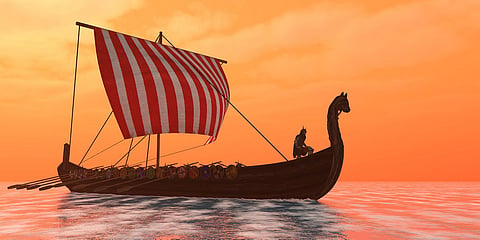

Norse Vikings from northern Europe were trading with indigenous North American Arctic peoples many years before Christopher Columbus landed on Hispaniola in 1492 Common Era, a study has concluded by conducting scientific analysis on artifacts made from walrus ivory.
The Norsemen and the indigenous people were all operating around the Pikialasorsuaq (North Water Polynya). This is an area of open water surrounded by sea ice. It lies between Greenland and Canada in the northern Baffin Bay of the North Atlantic Ocean.
Both sides “were targeting the same resources in the same historical period, making routine encounters almost certain and some degree of formalized exchange increasingly likely,” the researchers noted in their paper.
They also termed the Pikialasorsuaq “as the most likely arena for the earliest phases of circumpolar globalization”.
These encounters would have been historic since “they represent the first “full circle” reconnection of the two major branches of Pleistocene human dispersals out of Africa”, as per the researchers.
The scientists also concluded that “elite consumption patterns in Europe fueled an insatiable demand for walrus ivory, and that provisioning these markets emerged as a major driving force that substantially shaped the trajectory of Greenland Norse interactions with Arctic Indigenous peoples”.
The researchers embarked on the study with the aim of answering significant and hitherto unanswered historical questions.
They noted that the Arctic had experienced the dispersal and contraction of several major cultural groups during the Medieval Warm Period (ca. 950 to 1250 CE).
These included the maritime-adapted Thule Inuit, who expanded eastward from Alaska across Arctic Canada and into Greenland as early as the 13th century CE. Here, they encountered, displaced and replaced the Tuniit (Late Dorset Pre-Inuit) culture.
At the same time, the Vikings or Norsemen of Fennoscandia (Norway, Sweden, Denmark and Finland) were expanding west into the North Atlantic—first Iceland and then Greenland.
Their expansion may have been caused by a combination of population pressures and political unrest in the Norse homeland.
“Over the same period, groups with primary cultural and genealogical ties to Iceland and Scandinavia (collectively defined here as the Greenland Norse) settled in southwestern Greenland, explored surrounding regions, and established an export-led economy that supplied walrus ivory back to trade centers in Europe,” the paper notes.
The researchers wanted to know whether all the ivory passing through the Greenland Norse settlements was directly hunted by Norsemen, or partly, or even entirely, exchanged with Arctic Indigenous groups, as both Tuniit and the expanding Thule Inuit were also present in adjacent areas of Arctic Canada and northwest Greenland over the same broad historical interval.
They used a technique known as ‘genetic sourcing’ on 31 cultural artifacts made from Atlantic walrus (Odobenus rosmarus rosmarus).
The artifacts were found to be originating from specific Arctic hunting grounds, namely the Pikialasorsuaq (North Water Polynya). The results confirmed that walrus exploitation was central to Norse expansion further west from Greenland, deep into the High Arctic.
In the Early Warm Period, the Greenland Norse mainly targeted local stocks of walrus. By the Late Period though, soaring demand in Europe caused relentless overexploitation of more accessible walrus stocks.
This pushed Norse hunters into ever more remote areas in their search for valuable ivory. By the Late Period, “…primary harvesting appears to have shifted up to the High Arctic, with efforts focusing on the Pikialasorsuaq (North Water Polynya), and possibly expanding into the waters of the Foxe Basin”, the researchers found.
In this area, all three peoples — Norse, Thule Inuit and Tuniit — operated and exploited the same resources, making contact between them inevitable. The time of this interaction could in the 13th century, around 200 years before Christopher Columbus landed in the Caribbean.
Greenland Norse walrus exploitation deep into the Arctic was published in Science Advances.